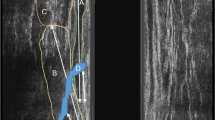Abstract
PURPOSE: Patients with anal incontinence attributable to trauma are usually treated by sphincter reconstruction. Failures because of incomplete reconstruction may possibly be detected by anal endosonography which gives detailed information on the anal sphincter muscles. The aim of this study was to describe the endosonographic findings in patients after sphincter reconstruction. MATERIALS AND METHODS: Ten female patients who had undergone surgical sphincter reconstruction using an overlapping technique because of anal incontinence were studied with anal endosonography a median of six months after surgery. Five patients were fully continent, three were incontinent for flatus, and two patients were still incontinent for solid stool at the time of this study. Eight patients had also been studied with endosonography before surgery, and, in these patients, we compared the initial sonograms with the follow-up sonograms. The angular extent of the endosonographic defects in the external sphincter before and after reconstruction was measured in degrees and compared with the outcome of surgery. RESULTS: After reconstruction, continuity of the external anal sphincter was completely restored at all levels in four patients, one of whom still had anal incontinence. Continuity was partially restored in three patients: two were fully continent, while one patient, previously incontinent for stool, was incontinent for flatus. In three patients the continuity was restored at one level but a persisting defect was found at a different level. In two of these patients the grade of incontinence was unchanged. Three patients also had defects in the internal anal sphincter. CONCLUSION: After surgical sphincter reconstruction for anal incontinence, we found sphincteric defects in six patients, including four of five patients who still had some degree of incontinence. Thus, endosonography may be used for postoperative assessment and may explain the unsatisfactory results of surgery in some patients. We recommend that endosonography be also performed preoperatively, whereby the effect of the operation on the size of the sphincteric defect can be assessed.
Similar content being viewed by others
References
Browning GG, Motson RW. Anal sphincter injury: management and results of Parks sphincter repair. Ann Surg 1984;199:351–7.
Christiansen J, Pedersen IK. Traumatic anal incontinence: results of surgical repair. Dis Colon Rectum 1987;30:189–91.
Wexner SD, Marchetti F, Jagelman DG. The role of sphincteroplasty for fecal incontinence reevaluated: a prospective physiologic and functional review. Dis Colon Rectum 1991;34:22–30.
Ctercteko GC, Fazio VW, Jagelman DG, Lavery IC, Weakley FL, Melia M. Anal sphincter repair: a report of 60 cases and review of the literature. Aust N Z J Surg 1988;58:703–10.
Nielsen MB, Pedersen JF, Hauge C, Rasmussen O, Christiansen J. Endosonography of the anal sphincter: findings in healthy volunteers. AJR 1991;157:1199–1202.
Law PJ, Kamm MA, Bartram CI. Anal endosonography in the investigation of faecal incontinence. Br J Surg 1991;78:312–4.
Cuesta MA, Meijer S, Derksen EJ, Boutkan H, Meuwissen SG. Anal sphincter imaging in fecal incontinence using endosonography. Dis Colon Rectum 1992;35:59–63.
Nielsen MB, Hauge C, Pedersen JF, Christiansen J. Endosonographic evaluation of patients with anal incontinence: findings and influence on surgical management. AJR 1993;160:771–5.
Kiff ES, Swash M. Slowed conduction in the pudendal nerves in idiopathic (neurogenic) faecal incontinence. Br J Surg 1984;71:614–6.
Krogh Pedersen I, Christiansen J. A study of the physiological variation in anal manometry. Br J Surg 1989;76:69–70.
Sørensen M, Tetzchner T, Rasmussen OØ, Christiansen J. Relations between electromyography and anal manometry of the external anal sphincter. Gut 1991;32:1031–4.
Christiansen J, Sørensen M, Rasmussen OØ. Gracilis muscle transposition for fecal incontinence. Br J Surg 1990;77:1039–40.
Christiansen J, Sparsø B. Treatment of anal incontinence by an implantable prosthetic anal sphincter. Ann Surg 1992;215:383–6.
Author information
Authors and Affiliations
About this article
Cite this article
Nielsen, M.B., Dammegaard, L. & Pedersen, J.F. Endosonographic assessment of the anal sphincter after surgical reconstruction. Dis Colon Rectum 37, 434–438 (1994). https://doi.org/10.1007/BF02076187
Issue Date:
DOI: https://doi.org/10.1007/BF02076187




